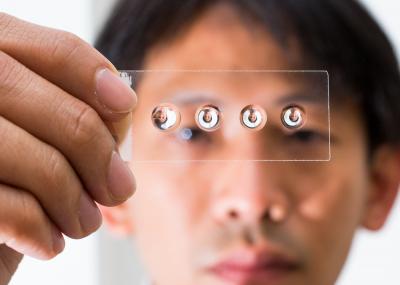Droplet lens – Turning smart phones into microscopes

Dr. Steve Lee inspects PDMS droplet lenses on a slide. Credit: Australian National University
Costing less than a cent, the lenses promise a revolution in science and medicine in developing countries and remote areas.
The lens fabrication technique was invented by Dr Steve Lee from The Australian National University (ANU) Research School of Engineering, who collaborated with Dr Tri Phan from Sydney's Garvan Institute of Medical Research to find ways to transform the lentil-sized lens into a medical imaging tool. The lenses are made by using the natural shape of liquid droplets.
“We put a droplet of polymer onto a microscope cover slip and then invert it. Then we let gravity do the work, to pull it into the perfect curvature,” Dr Lee said.
“By successively adding small amounts of fluid to the droplet, we discovered that we can reach a magnifying power of up to 160 times with an imaging resolution of four micrometers.”
The polymer, polydimethylsiloxane (PDMS), is the same as that used for contact lenses, and it won't break or scratch.
“It would be perfect for the third world. All you need is a fine tipped tool, a cover slip, some polymer and an oven,” Dr Lee said.
The first droplet lens was made by accident.
“I nearly threw them away. I happened to mention them to my colleague Tri Phan, and he got very excited,” Dr Lee said.
“So then I decided to try to find the optimum shape, to see how far I could go. When I saw the first images of yeast cells I was like, 'Wow!'”
Dr Lee and his team worked with Dr Phan to design a lightweight 3D-printable frame to hold the lens, along with a couple of miniature LED lights for illumination, and a coin battery.
The technology taps into the current citizen science revolution, which is rapidly transforming owners of smart phones into potential scientists. There are also exciting possibilities for remote medical diagnosis.
Dr Phan said the tiny microscope has a wide range of potential uses, particularly if coupled with the right smartphone apps.
“This is a whole new era of miniaturisation and portability – image analysis software could instantly transform most smartphones into sophisticated mobile laboratories,” Dr Phan said.
“I am most able to see the potential for this device in the practice of medicine, although I am sure specialists in other fields will immediately see its value for them.”
Dr Lee said the low-cost lens had already attracted interest from a German group interested in using disposable lenses for tele-dermatology.
“There are also possibilities for farmers,” he said. “They can photograph fungus or insects on their crops, upload the pictures to the internet where a specialist can identify if they are a problem or not.”
The lens making technology is described in the latest issue of Biomedical Optics Express, published by The Optical Society.
A video will be available from 11pm AEST at http://youtu.be/t63aCxFqDv0.
(NOTE: B-roll vision is available at https://www.dropbox.com/s/0e3aiapse6k9r3a/Droplet_lens_dropbox_VNR_editmaster.mp4 Higher resolution video and photographs are available upon request to the ANU media office on +61 (2) 6125 7979.)
FOR INTERVIEW:
Dr Woei Ming (Steve) Lee
ANU Research School of Engineering
T: +61 (2) 6125 6058
M: +61 (0) 424 742 314
E: steve.lee@anu.edu.au
Dr Tri Phan
Garvan Institute of Medical Research
T: +61 (2) 9295 8414
M: +61 (0) 415 888 294
E: t.phan@garvan.org.au
For media assistance, call the ANU media hotline: +61 (2) 6125 7979.
Contact the Garvan Institute on +61 (0) 434 071 326.
Media Contact
All latest news from the category: Physics and Astronomy
This area deals with the fundamental laws and building blocks of nature and how they interact, the properties and the behavior of matter, and research into space and time and their structures.
innovations-report provides in-depth reports and articles on subjects such as astrophysics, laser technologies, nuclear, quantum, particle and solid-state physics, nanotechnologies, planetary research and findings (Mars, Venus) and developments related to the Hubble Telescope.
Newest articles

Superradiant atoms could push the boundaries of how precisely time can be measured
Superradiant atoms can help us measure time more precisely than ever. In a new study, researchers from the University of Copenhagen present a new method for measuring the time interval,…

Ion thermoelectric conversion devices for near room temperature
The electrode sheet of the thermoelectric device consists of ionic hydrogel, which is sandwiched between the electrodes to form, and the Prussian blue on the electrode undergoes a redox reaction…

Zap Energy achieves 37-million-degree temperatures in a compact device
New publication reports record electron temperatures for a small-scale, sheared-flow-stabilized Z-pinch fusion device. In the nine decades since humans first produced fusion reactions, only a few fusion technologies have demonstrated…





















